CPCCBC4003A - Analyzing Essential Elements of a Low Rise Contract
VerifiedAdded on 2023/06/03
|6
|1491
|145
Report
AI Summary
This report provides a detailed analysis of the essential elements of a low-rise construction contract, including different types of contracts such as lump sum, cost plus, unit price, target cost, and time & material contracts. It outlines the rights and responsibilities of key parties involved, including the client, consultant, contractor, and government authorities. The report further examines circumstances that can lead to a breach of contract, such as failure to meet responsibilities, lack of funds, miscommunication, or unforeseen risks. References to relevant academic sources and online resources are provided to support the analysis. Desklib provides this and other solved assignments to help students.
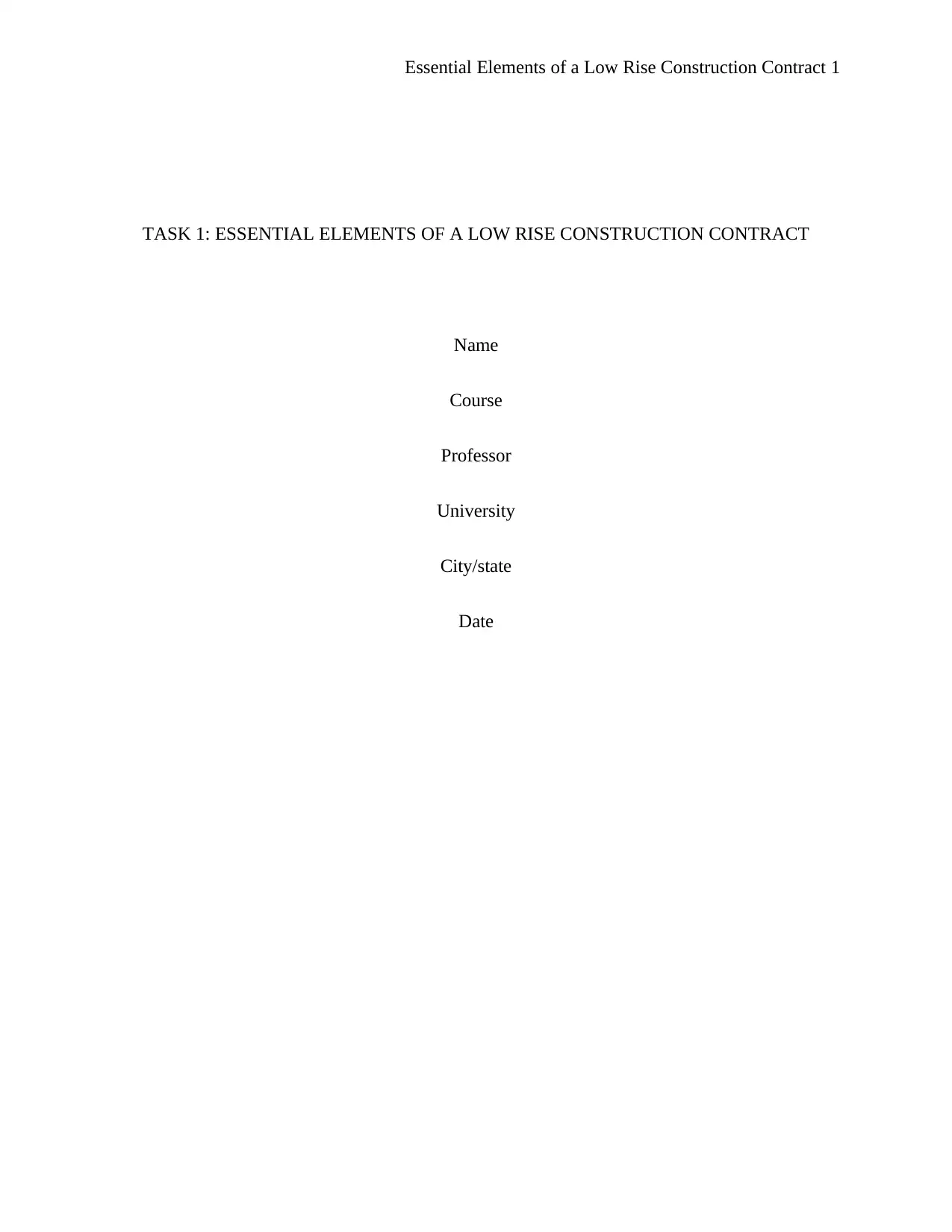
Essential Elements of a Low Rise Construction Contract 1
TASK 1: ESSENTIAL ELEMENTS OF A LOW RISE CONSTRUCTION CONTRACT
Name
Course
Professor
University
City/state
Date
TASK 1: ESSENTIAL ELEMENTS OF A LOW RISE CONSTRUCTION CONTRACT
Name
Course
Professor
University
City/state
Date
Paraphrase This Document
Need a fresh take? Get an instant paraphrase of this document with our AI Paraphraser
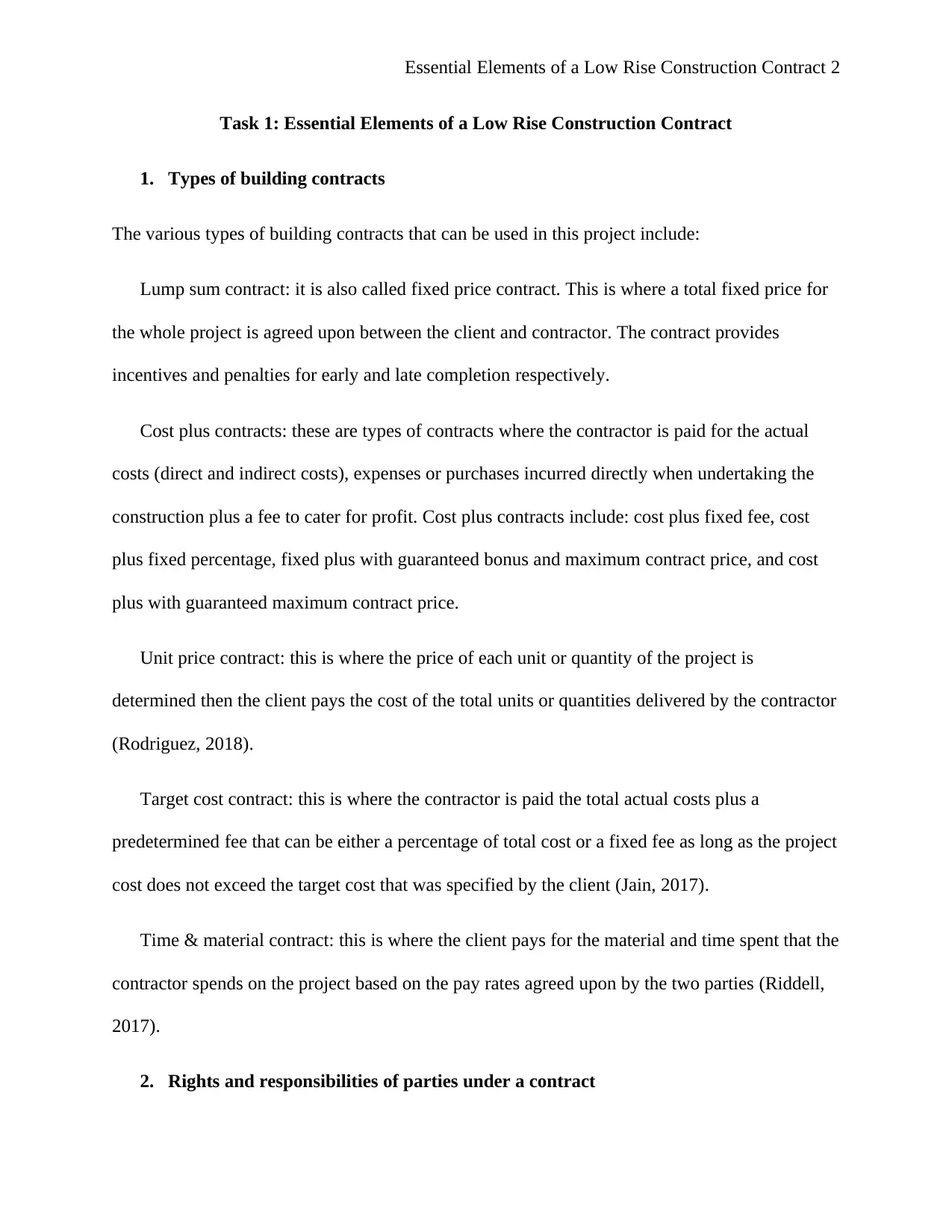
Essential Elements of a Low Rise Construction Contract 2
Task 1: Essential Elements of a Low Rise Construction Contract
1. Types of building contracts
The various types of building contracts that can be used in this project include:
Lump sum contract: it is also called fixed price contract. This is where a total fixed price for
the whole project is agreed upon between the client and contractor. The contract provides
incentives and penalties for early and late completion respectively.
Cost plus contracts: these are types of contracts where the contractor is paid for the actual
costs (direct and indirect costs), expenses or purchases incurred directly when undertaking the
construction plus a fee to cater for profit. Cost plus contracts include: cost plus fixed fee, cost
plus fixed percentage, fixed plus with guaranteed bonus and maximum contract price, and cost
plus with guaranteed maximum contract price.
Unit price contract: this is where the price of each unit or quantity of the project is
determined then the client pays the cost of the total units or quantities delivered by the contractor
(Rodriguez, 2018).
Target cost contract: this is where the contractor is paid the total actual costs plus a
predetermined fee that can be either a percentage of total cost or a fixed fee as long as the project
cost does not exceed the target cost that was specified by the client (Jain, 2017).
Time & material contract: this is where the client pays for the material and time spent that the
contractor spends on the project based on the pay rates agreed upon by the two parties (Riddell,
2017).
2. Rights and responsibilities of parties under a contract
Task 1: Essential Elements of a Low Rise Construction Contract
1. Types of building contracts
The various types of building contracts that can be used in this project include:
Lump sum contract: it is also called fixed price contract. This is where a total fixed price for
the whole project is agreed upon between the client and contractor. The contract provides
incentives and penalties for early and late completion respectively.
Cost plus contracts: these are types of contracts where the contractor is paid for the actual
costs (direct and indirect costs), expenses or purchases incurred directly when undertaking the
construction plus a fee to cater for profit. Cost plus contracts include: cost plus fixed fee, cost
plus fixed percentage, fixed plus with guaranteed bonus and maximum contract price, and cost
plus with guaranteed maximum contract price.
Unit price contract: this is where the price of each unit or quantity of the project is
determined then the client pays the cost of the total units or quantities delivered by the contractor
(Rodriguez, 2018).
Target cost contract: this is where the contractor is paid the total actual costs plus a
predetermined fee that can be either a percentage of total cost or a fixed fee as long as the project
cost does not exceed the target cost that was specified by the client (Jain, 2017).
Time & material contract: this is where the client pays for the material and time spent that the
contractor spends on the project based on the pay rates agreed upon by the two parties (Riddell,
2017).
2. Rights and responsibilities of parties under a contract
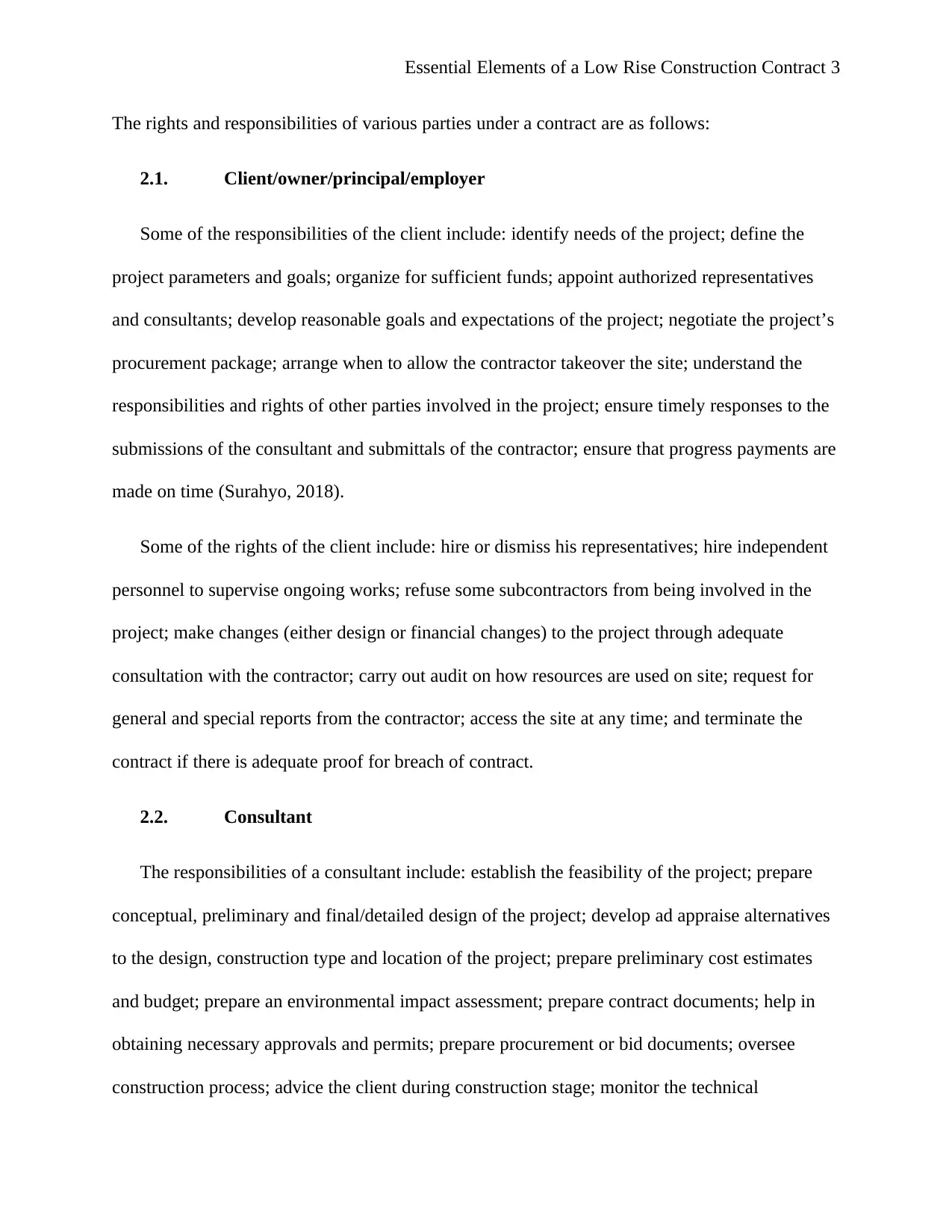
Essential Elements of a Low Rise Construction Contract 3
The rights and responsibilities of various parties under a contract are as follows:
2.1. Client/owner/principal/employer
Some of the responsibilities of the client include: identify needs of the project; define the
project parameters and goals; organize for sufficient funds; appoint authorized representatives
and consultants; develop reasonable goals and expectations of the project; negotiate the project’s
procurement package; arrange when to allow the contractor takeover the site; understand the
responsibilities and rights of other parties involved in the project; ensure timely responses to the
submissions of the consultant and submittals of the contractor; ensure that progress payments are
made on time (Surahyo, 2018).
Some of the rights of the client include: hire or dismiss his representatives; hire independent
personnel to supervise ongoing works; refuse some subcontractors from being involved in the
project; make changes (either design or financial changes) to the project through adequate
consultation with the contractor; carry out audit on how resources are used on site; request for
general and special reports from the contractor; access the site at any time; and terminate the
contract if there is adequate proof for breach of contract.
2.2. Consultant
The responsibilities of a consultant include: establish the feasibility of the project; prepare
conceptual, preliminary and final/detailed design of the project; develop ad appraise alternatives
to the design, construction type and location of the project; prepare preliminary cost estimates
and budget; prepare an environmental impact assessment; prepare contract documents; help in
obtaining necessary approvals and permits; prepare procurement or bid documents; oversee
construction process; advice the client during construction stage; monitor the technical
The rights and responsibilities of various parties under a contract are as follows:
2.1. Client/owner/principal/employer
Some of the responsibilities of the client include: identify needs of the project; define the
project parameters and goals; organize for sufficient funds; appoint authorized representatives
and consultants; develop reasonable goals and expectations of the project; negotiate the project’s
procurement package; arrange when to allow the contractor takeover the site; understand the
responsibilities and rights of other parties involved in the project; ensure timely responses to the
submissions of the consultant and submittals of the contractor; ensure that progress payments are
made on time (Surahyo, 2018).
Some of the rights of the client include: hire or dismiss his representatives; hire independent
personnel to supervise ongoing works; refuse some subcontractors from being involved in the
project; make changes (either design or financial changes) to the project through adequate
consultation with the contractor; carry out audit on how resources are used on site; request for
general and special reports from the contractor; access the site at any time; and terminate the
contract if there is adequate proof for breach of contract.
2.2. Consultant
The responsibilities of a consultant include: establish the feasibility of the project; prepare
conceptual, preliminary and final/detailed design of the project; develop ad appraise alternatives
to the design, construction type and location of the project; prepare preliminary cost estimates
and budget; prepare an environmental impact assessment; prepare contract documents; help in
obtaining necessary approvals and permits; prepare procurement or bid documents; oversee
construction process; advice the client during construction stage; monitor the technical
⊘ This is a preview!⊘
Do you want full access?
Subscribe today to unlock all pages.

Trusted by 1+ million students worldwide
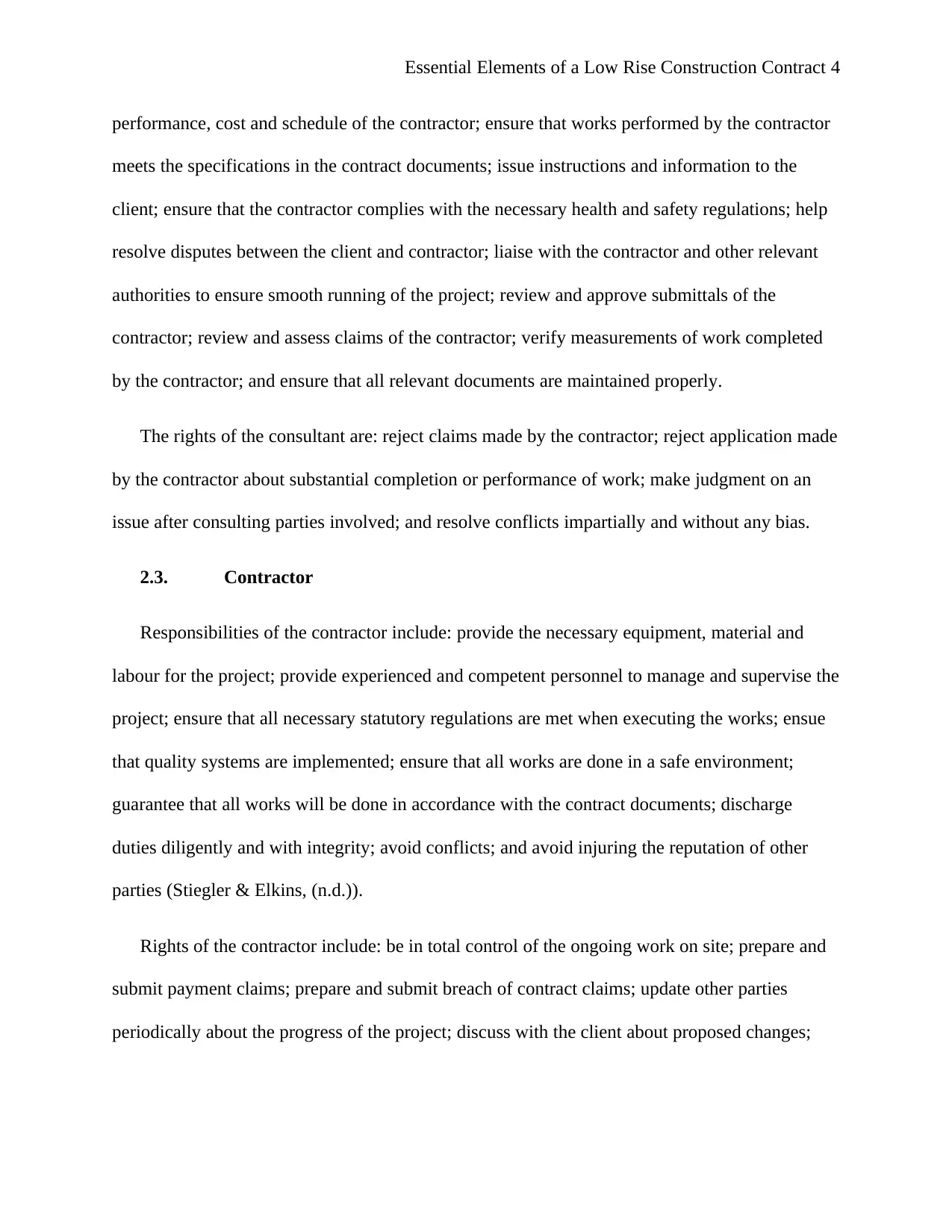
Essential Elements of a Low Rise Construction Contract 4
performance, cost and schedule of the contractor; ensure that works performed by the contractor
meets the specifications in the contract documents; issue instructions and information to the
client; ensure that the contractor complies with the necessary health and safety regulations; help
resolve disputes between the client and contractor; liaise with the contractor and other relevant
authorities to ensure smooth running of the project; review and approve submittals of the
contractor; review and assess claims of the contractor; verify measurements of work completed
by the contractor; and ensure that all relevant documents are maintained properly.
The rights of the consultant are: reject claims made by the contractor; reject application made
by the contractor about substantial completion or performance of work; make judgment on an
issue after consulting parties involved; and resolve conflicts impartially and without any bias.
2.3. Contractor
Responsibilities of the contractor include: provide the necessary equipment, material and
labour for the project; provide experienced and competent personnel to manage and supervise the
project; ensure that all necessary statutory regulations are met when executing the works; ensue
that quality systems are implemented; ensure that all works are done in a safe environment;
guarantee that all works will be done in accordance with the contract documents; discharge
duties diligently and with integrity; avoid conflicts; and avoid injuring the reputation of other
parties (Stiegler & Elkins, (n.d.)).
Rights of the contractor include: be in total control of the ongoing work on site; prepare and
submit payment claims; prepare and submit breach of contract claims; update other parties
periodically about the progress of the project; discuss with the client about proposed changes;
performance, cost and schedule of the contractor; ensure that works performed by the contractor
meets the specifications in the contract documents; issue instructions and information to the
client; ensure that the contractor complies with the necessary health and safety regulations; help
resolve disputes between the client and contractor; liaise with the contractor and other relevant
authorities to ensure smooth running of the project; review and approve submittals of the
contractor; review and assess claims of the contractor; verify measurements of work completed
by the contractor; and ensure that all relevant documents are maintained properly.
The rights of the consultant are: reject claims made by the contractor; reject application made
by the contractor about substantial completion or performance of work; make judgment on an
issue after consulting parties involved; and resolve conflicts impartially and without any bias.
2.3. Contractor
Responsibilities of the contractor include: provide the necessary equipment, material and
labour for the project; provide experienced and competent personnel to manage and supervise the
project; ensure that all necessary statutory regulations are met when executing the works; ensue
that quality systems are implemented; ensure that all works are done in a safe environment;
guarantee that all works will be done in accordance with the contract documents; discharge
duties diligently and with integrity; avoid conflicts; and avoid injuring the reputation of other
parties (Stiegler & Elkins, (n.d.)).
Rights of the contractor include: be in total control of the ongoing work on site; prepare and
submit payment claims; prepare and submit breach of contract claims; update other parties
periodically about the progress of the project; discuss with the client about proposed changes;
Paraphrase This Document
Need a fresh take? Get an instant paraphrase of this document with our AI Paraphraser
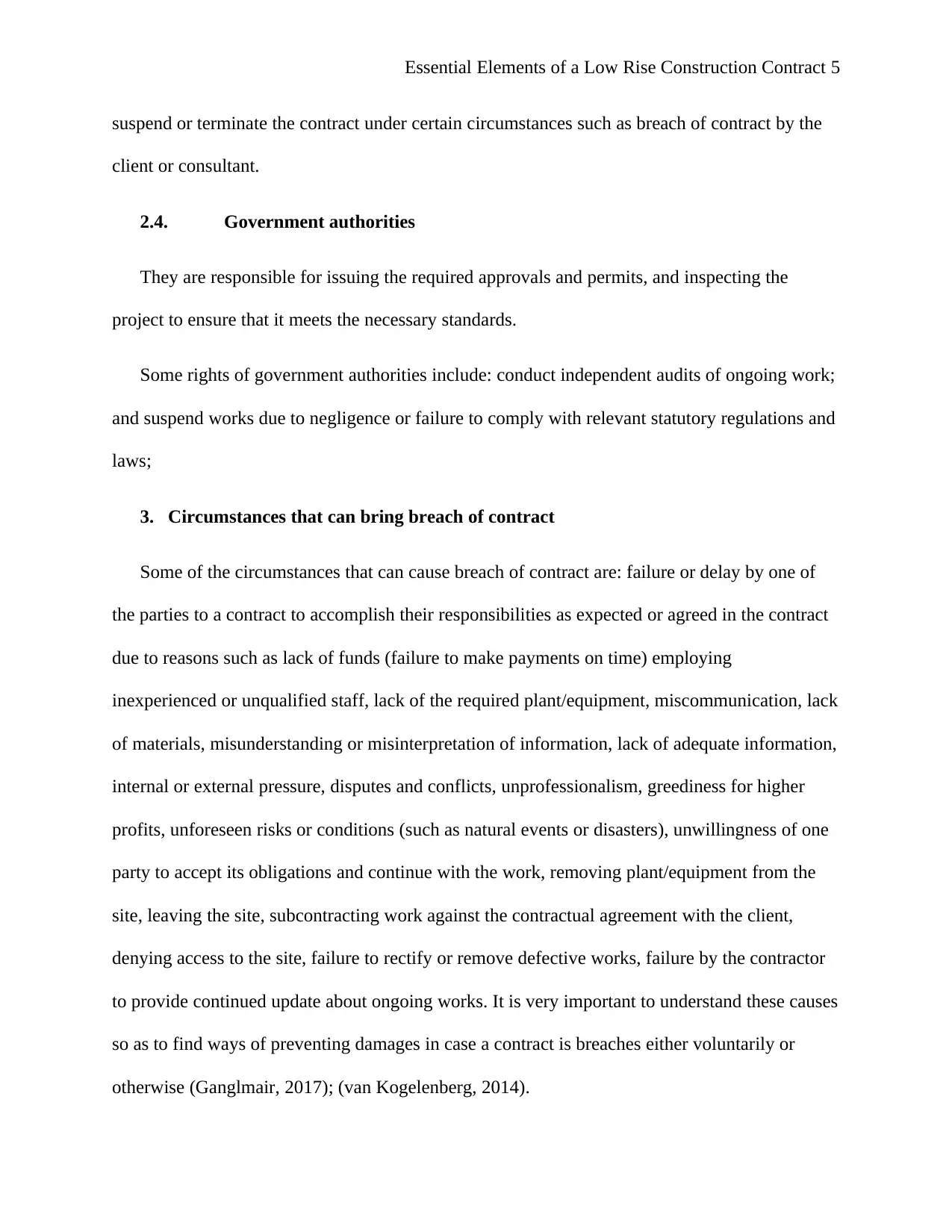
Essential Elements of a Low Rise Construction Contract 5
suspend or terminate the contract under certain circumstances such as breach of contract by the
client or consultant.
2.4. Government authorities
They are responsible for issuing the required approvals and permits, and inspecting the
project to ensure that it meets the necessary standards.
Some rights of government authorities include: conduct independent audits of ongoing work;
and suspend works due to negligence or failure to comply with relevant statutory regulations and
laws;
3. Circumstances that can bring breach of contract
Some of the circumstances that can cause breach of contract are: failure or delay by one of
the parties to a contract to accomplish their responsibilities as expected or agreed in the contract
due to reasons such as lack of funds (failure to make payments on time) employing
inexperienced or unqualified staff, lack of the required plant/equipment, miscommunication, lack
of materials, misunderstanding or misinterpretation of information, lack of adequate information,
internal or external pressure, disputes and conflicts, unprofessionalism, greediness for higher
profits, unforeseen risks or conditions (such as natural events or disasters), unwillingness of one
party to accept its obligations and continue with the work, removing plant/equipment from the
site, leaving the site, subcontracting work against the contractual agreement with the client,
denying access to the site, failure to rectify or remove defective works, failure by the contractor
to provide continued update about ongoing works. It is very important to understand these causes
so as to find ways of preventing damages in case a contract is breaches either voluntarily or
otherwise (Ganglmair, 2017); (van Kogelenberg, 2014).
suspend or terminate the contract under certain circumstances such as breach of contract by the
client or consultant.
2.4. Government authorities
They are responsible for issuing the required approvals and permits, and inspecting the
project to ensure that it meets the necessary standards.
Some rights of government authorities include: conduct independent audits of ongoing work;
and suspend works due to negligence or failure to comply with relevant statutory regulations and
laws;
3. Circumstances that can bring breach of contract
Some of the circumstances that can cause breach of contract are: failure or delay by one of
the parties to a contract to accomplish their responsibilities as expected or agreed in the contract
due to reasons such as lack of funds (failure to make payments on time) employing
inexperienced or unqualified staff, lack of the required plant/equipment, miscommunication, lack
of materials, misunderstanding or misinterpretation of information, lack of adequate information,
internal or external pressure, disputes and conflicts, unprofessionalism, greediness for higher
profits, unforeseen risks or conditions (such as natural events or disasters), unwillingness of one
party to accept its obligations and continue with the work, removing plant/equipment from the
site, leaving the site, subcontracting work against the contractual agreement with the client,
denying access to the site, failure to rectify or remove defective works, failure by the contractor
to provide continued update about ongoing works. It is very important to understand these causes
so as to find ways of preventing damages in case a contract is breaches either voluntarily or
otherwise (Ganglmair, 2017); (van Kogelenberg, 2014).
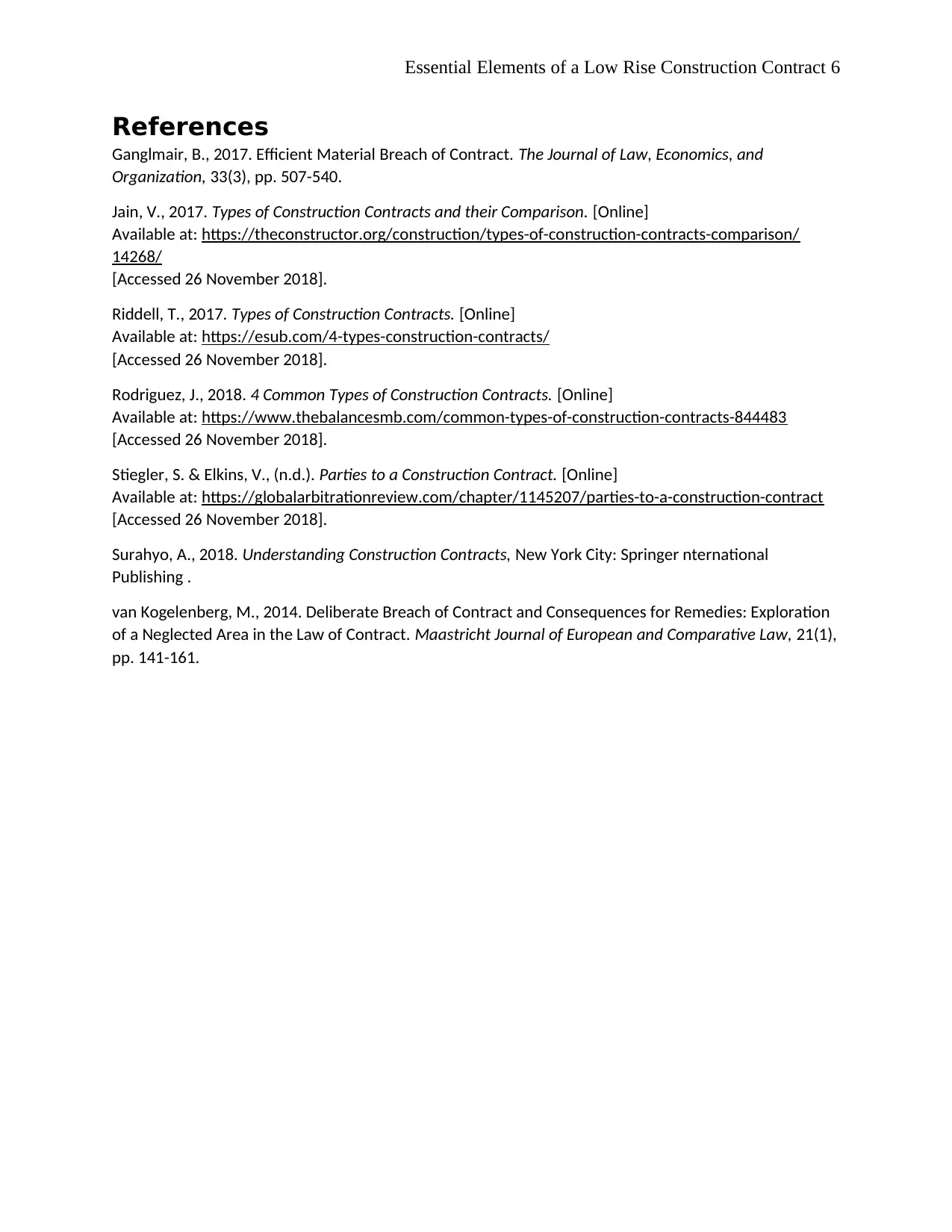
Essential Elements of a Low Rise Construction Contract 6
References
Ganglmair, B., 2017. Efficient Material Breach of Contract. The Journal of Law, Economics, and
Organization, 33(3), pp. 507-540.
Jain, V., 2017. Types of Construction Contracts and their Comparison. [Online]
Available at: https://theconstructor.org/construction/types-of-construction-contracts-comparison/
14268/
[Accessed 26 November 2018].
Riddell, T., 2017. Types of Construction Contracts. [Online]
Available at: https://esub.com/4-types-construction-contracts/
[Accessed 26 November 2018].
Rodriguez, J., 2018. 4 Common Types of Construction Contracts. [Online]
Available at: https://www.thebalancesmb.com/common-types-of-construction-contracts-844483
[Accessed 26 November 2018].
Stiegler, S. & Elkins, V., (n.d.). Parties to a Construction Contract. [Online]
Available at: https://globalarbitrationreview.com/chapter/1145207/parties-to-a-construction-contract
[Accessed 26 November 2018].
Surahyo, A., 2018. Understanding Construction Contracts, New York City: Springer nternational
Publishing .
van Kogelenberg, M., 2014. Deliberate Breach of Contract and Consequences for Remedies: Exploration
of a Neglected Area in the Law of Contract. Maastricht Journal of European and Comparative Law, 21(1),
pp. 141-161.
References
Ganglmair, B., 2017. Efficient Material Breach of Contract. The Journal of Law, Economics, and
Organization, 33(3), pp. 507-540.
Jain, V., 2017. Types of Construction Contracts and their Comparison. [Online]
Available at: https://theconstructor.org/construction/types-of-construction-contracts-comparison/
14268/
[Accessed 26 November 2018].
Riddell, T., 2017. Types of Construction Contracts. [Online]
Available at: https://esub.com/4-types-construction-contracts/
[Accessed 26 November 2018].
Rodriguez, J., 2018. 4 Common Types of Construction Contracts. [Online]
Available at: https://www.thebalancesmb.com/common-types-of-construction-contracts-844483
[Accessed 26 November 2018].
Stiegler, S. & Elkins, V., (n.d.). Parties to a Construction Contract. [Online]
Available at: https://globalarbitrationreview.com/chapter/1145207/parties-to-a-construction-contract
[Accessed 26 November 2018].
Surahyo, A., 2018. Understanding Construction Contracts, New York City: Springer nternational
Publishing .
van Kogelenberg, M., 2014. Deliberate Breach of Contract and Consequences for Remedies: Exploration
of a Neglected Area in the Law of Contract. Maastricht Journal of European and Comparative Law, 21(1),
pp. 141-161.
⊘ This is a preview!⊘
Do you want full access?
Subscribe today to unlock all pages.

Trusted by 1+ million students worldwide
1 out of 6
Related Documents
Your All-in-One AI-Powered Toolkit for Academic Success.
+13062052269
info@desklib.com
Available 24*7 on WhatsApp / Email
![[object Object]](/_next/static/media/star-bottom.7253800d.svg)
Unlock your academic potential
Copyright © 2020–2025 A2Z Services. All Rights Reserved. Developed and managed by ZUCOL.





